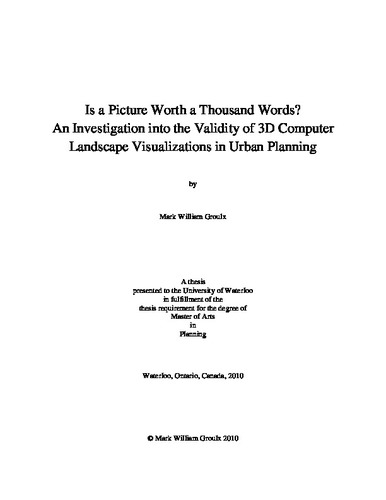| dc.contributor.author | Groulx, Mark | |
| dc.date.accessioned | 2010-04-14 13:31:52 (GMT) | |
| dc.date.available | 2010-04-14 13:31:52 (GMT) | |
| dc.date.issued | 2010-04-14T13:31:52Z | |
| dc.date.submitted | 2010 | |
| dc.identifier.uri | http://hdl.handle.net/10012/5065 | |
| dc.description.abstract | This study examined the use of computer visualizations in urban planning and whether they facilitate effective decision-making and communication within community engagement. The objective was to determine the potential for the human element in the visualization process to impact the public’s evaluations of a future landscape. A response equivalence experiment was performed that compared evaluations based on actual urban landscapes to those based on accurately prepared, as well as intentionally persuasive, visualizations of the same landscapes. To ensure the persuasive visualizations assessed were akin to those used in practice an investigation of procedures and professional attitudes regarding visualization use was carried out, including surveys of municipal planning departments and key-informant interviews with visualization preparers. Results from the response equivalence analysis show that a visualization preparer can positively influence preferences for an urban park or mixed use streetscape by using subtle techniques that enhance the aesthetic appearance of the virtual environment. These same techniques also have a considerable impact on aspects of landscape perception such as maintenance, safety, social inclusiveness and place identity. Findings indicate that qualitative instruments are necessary for measuring response equivalence as social aspects of landscape perception are important to the validity of simulations. Finally, it is argued that the current context of visualization use in planning practice is a threat to legitimate public engagement and the health of stakeholder relationships. A two pronged approach to effective visualization use is proposed, suggesting equal emphasis on changing professional attitudes toward the technology and creating a public with a deeper understanding of the visualization process. | en |
| dc.language.iso | en | en |
| dc.publisher | University of Waterloo | en |
| dc.subject | Visualization | en |
| dc.subject | Community Engagement | en |
| dc.title | Is a Picture Worth a Thousand Words? An Investigation into the Validity of 3D Computer Landscape Visualizations in Urban Planning | en |
| dc.type | Master Thesis | en |
| dc.pending | false | en |
| dc.subject.program | Planning | en |
| uws-etd.degree.department | Planning | en |
| uws-etd.degree | Master of Arts | en |
| uws.typeOfResource | Text | en |
| uws.peerReviewStatus | Unreviewed | en |
| uws.scholarLevel | Graduate | en |

